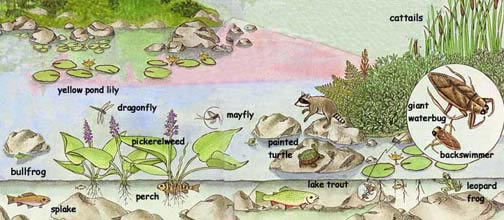

Ponds and lakes are found all over the world. They may even form in deserts after a rain for a short time.
Underwater life can be a dangerous place. Small animals often fall prey to larger animal. When the weather turns cold, animals must find places to hibernate or freeze with the water. Pollutants, such as: acid rain, fertilizer run off and pesticides affect all the animals and plants that live underwater.
Water insects are not always easy to find. They are hiding from fish and the many other predators in and on the water. The giant water bug can reach 2.5" long and has a sharp beak with which it can stab with. Its bite is even more dangerous to prey because it has a poison that makes them sleepy. Be careful if you find one. They play dead and then give a painful bite. The water boatman can be found zig-zagging around in the water wherever there is algae available to eat. People often find them in still ponds and garden birdbaths.
Many kinds of fish live together in northern ponds and lakes, like: trout, bass, bullhead, sunfish, crappie, carp, pike, perch and walleye to name just a few.
Some kinds of frogs spend most of their time in the water, like: bullfrogs, green frogs, pickerel and leopard frogs. All frogs and toads lay their eggs in the water. The hatching tadpoles stay underwater until they become the adult frogs.
Dragonflies, damselflies, and mayflies all spend one stage of their lives (larval stage) underwater and hatch out of the water only when they become adults. Adult mayflies hatch out in a big mass, making a dark cloud of insects over the water. They look like they are dancing. They live as adults for only a few hours, long enough to mate and lay eggs. Then they die and the cycle begins again. In this stage, they don't have time to eat, as adult mayflies don't even have mouths! Water striders skate across the surface of the water and whirligig beetles circle around and around.
Many plants make their living in ponds and lakes. Cattails and pickerelweed root in the bottom of lakes and ponds and grow right out of the water. Pond lilies lie on the surface of the water, their roots stretching down into the soil beneath.
When you research information you must cite the reference. Citing for websites is different from citing from books, magazines and periodicals. The style of citing shown here is from the MLA Style Citations (Modern Language Association).
When citing a WEBSITE the general format is as follows.
Author Last Name, First Name(s). "Title: Subtitle of Part of Web Page, if appropriate." Title: Subtitle: Section of Page if appropriate. Sponsoring/Publishing Agency, If Given. Additional significant descriptive information. Date of Electronic Publication or other Date, such as Last Updated. Day Month Year of access < URL >.
Amsel, Sheri. "Northern Ponds & Lakes - Underwater Life" Exploring Nature Educational Resource ©2005-2024. December 13, 2024
< http://www.exploringnature.org/db/view/Northern-Ponds-and-Lakes-Underwater-Life >

